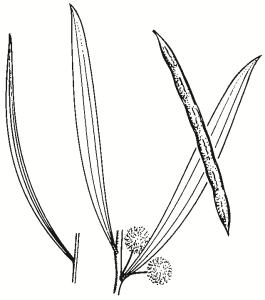Family:
Fabaceae
Acacia verniciflua
Varnish Wattle
Other Names:

Name Origin:
Common name ‘Varnish’ — refers to the shiny or sticky ‘leaf’ appearance.
Regional Subspecies:
Occurrence:
Regional:
Widespread throughout region on lower slopes and rises. Less common in the western, drier areas.
Australia:
Qld, NSW, Vic, Tas, SA.
Habitat:
Chiefly dry sclerophyll forest. Often along rocky streams or skeletal ridges. Also in Box woodland.
Habit:
Erect or spreading tree or shrub 1-5 m high. Finely fissured grey bark, angled or flattened, usually resinous branchlets, and resinous ‘leaves’ 3-14 cm long.
Site Preference:
Well-drained shallow soil. Tolerates moderate frost and extended dry periods.
Flowering:
Golden-yellow, Aug-Oct.
Seed Collection:
Mid Nov to early Jan, when pods brown and sticky.
Propagation:
From scarified seed (± 63 viable seeds per gram). Pour boiling over seeds and soak for several hours before drying and sowing.
Regeneration:
From seed, particularly after fire. Establishes readily when direct seeded.
VALUES:
Shade & Shelter:
Useful low-level cover for windbreaks.
Land Protection:
Useful for controlling soil erosion due to soil-binding fibrous roots. Legume — improves soil fertility by ‘fixing’ nitrogen.
Wildlife:
Excellent habitat. Flowers are a pollen source for native moths, butterflies and other insects. Insect-eating birds such as the Regent Honeyeater attracted. Seed source for parrots and native pigeons. Grubs living in bark are food for native birds.
First Nations:
Reputedly used to stupefy fish before capture.
Ornamental:
Attractive, with glistening resinous foliage and bright yellow flowers.
Other:
Not known to be grazed by livestock.
